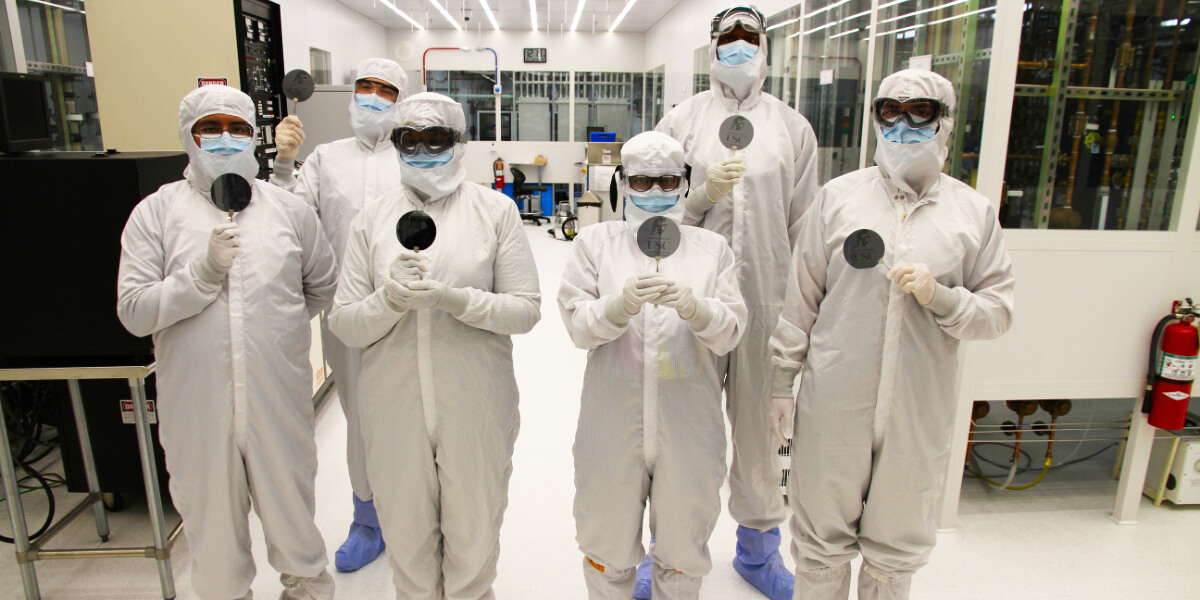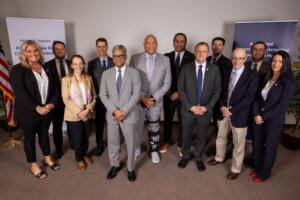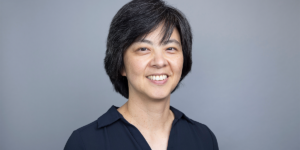
Photo Credit: Jonathan Van Dyke/USC ISI
South Central Los Angeles native John Paul recently began work as a security guard. It is a steady job, but also one he doesn’t necessarily view as a long-term career. He still has other designs for his life.
His aunt, a high school teacher at the Los Angeles Unified School District, had always encouraged him to explore STEM education and careers. When a new opportunity from the CHIPS Technician Fellows Program came across her desk in the spring, she immediately forwarded it to her nephew.
Adapted from a successful program at the University of California Santa Barbara by the California Defense Ready Electronics and Microdevices Superhub (DREAMS), the CHIPS Technician Fellows Program was created to develop a new pipeline of workers into the semiconductor and microelectronics industry by giving them their first experiences in a cleanroom setting. This is a vital experience for anyone seeking to be a technician or operator in the industry, which will be adding thousands of jobs across the country in the coming decade. Paul was one of six fellows in the inaugural cohort, which took place in May 2024.
“At first glance, I wasn’t sure I wanted to do it,” Paul said. “I had just gotten the security job, so balancing my schedule, I wasn’t sure it could work.”
But still, Paul knew this could be a real opportunity to break into a technical field. He had fond memories of a high school chemistry class where the teacher made the work fun and engaging. He always enjoyed the meticulous nature of working in a lab setting — he just had not found a way back to it.
“Realistically, this is important technology,” Paul said. “Working in anything regarding STEM is good. Especially for me, this opportunity pretty much fell into my lap. You don’t want to pass that up.”
The CHIPS Technician Fellows Program is tapping into a community that is often ignored: workers who want to acquire new skills outside traditional classroom instruction. These candidates are ideal to take the course and become semiconductor technicians or pursue further education. No prior education or specific skill set is required of participants, but it is helpful to be good with their hands and comfortable working in personal protective equipment (PPE), while also having a willingness to follow instructions, work on their feet for hours at a time and be mindful of safety considerations in the work environment.
The inaugural cohort of the CHIPS Technician Fellows Program included learners ranging from 22 and 46 years old, with a diverse set of backgrounds, education and skill sets. Paul was looking to better his prospects by exploring a job in a growing field. The experiences of his fellow learners ran the gamut: from an aspiring actor looking for a solid job in a cutting-edge trade, to a fellow hoping to expand her science expertise.
Taking the first steps toward a new career
Semiconductors and microelectronics are made primarily in cleanrooms, controlled environments that filter pollutants like dust, airborne microbes and aerosol particles to provide the cleanest area possible. The cohort’s time was split between classroom and hands-on training in the University of Southern California John O’Brien Nanofabrication Laboratory cleanroom, under the instruction of Associate Director Shiva Bhaskaran.
During their two weeks at the USC Viterbi School of Engineering, participants learned the basics of cleanroom operations, trained on 10 pieces of equipment and produced two microdevices. First, they produced a wafer — a thin circular slice of a semiconductor — overlaid with a special art pattern of a USC Trojan. Next, they produced a neural probe, which can be used to monitor vital signs in medical devices. Each device required the careful consideration of step-by-step directions called a process.
By completing these two processes, participants now have demonstrated that they can operate cleanroom equipment and follow the steps necessary to work as a cleanroom technician or operator, skills that will give them an advantage when looking for fulltime work in this field.
The Fellows Program culminated with a career day where participants met with defense industry hiring team members from Attollo Engineering, Boeing, HRL, Northrop Grumman and Teledyne.
A better way to learn
Saniyyah Rasheed, one of the students, has fond memories of her time majoring in Black Studies at California State University, Long Beach. And since then, she has always sought to diversify her knowledge and expand her horizons.
Currently, she works closely with incarcerated youth, and after hearing about the Fellows Program through a friend’s posting on Facebook, she decided to check it out. Rasheed said she was upfront about wanting to see if there is a way to incorporate formerly incarcerated youth into the program’s pipeline. But she also enjoyed exploring this field’s possibilities for herself.
“I’m a lover of science, and I’ve just been so intrigued by everything I’ve experienced during this program. I can’t stop talking about it,” she said. “The most exciting thing about it is to be able to learn hands on, and then ask the questions while you’re learning to gain the knowledge of how things work. I think that’s a better way to learn.”
Bhaskaran marveled at the group’s progress. “The first day they arrived, they couldn’t really understand what was going on. They were so exhausted and overwhelmed being in the cleanroom,” he said. “But by the end of the two weeks, they were super fast and efficient. They could gown up, handle the tweezers, understand the instructions and really understand what’s going on in the cleanroom. The learning curve was steep, but they could handle the pressure with everything thrown at them. What hiring managers care about is that they are safe and follow instructions. We achieved that.”
Industry partners who participated in the Career Day agreed that it is important to strengthen workforce pipelines and discover new ways to find eager and qualified candidates.
“With a 10,000-square-foot cleanroom that runs three shifts, HRL Laboratories has ongoing needs for the right technical talent to keep things running smoothly and meet our goals,” said Genny Findlay, chief human resources officer at HRL. “The CHIPS Technician Fellows Program helps ensure that we can find the right talent as we continue to grow.”
Graduation day
After completing the program, Paul was proud of his work and excited, if a little nervous, about what opportunities might lie ahead.
“It was a lot easier than I thought it would be,” he said. “I always believed you needed to be knee-deep in all of the information surrounding this, but you don’t really have to.”
Continued support will be provided by Jalil Bishop, who is president of MUME Collective, which leads the recruiting and support for the CHIPS Technician Fellows Program. Throughout the two weeks, he and his team were checking in with participants and receiving feedback to improve the program.
“Finishing the two weeks is not the end point,” Bishop said. Indeed, one fellow has earned an internship and two others have had several job interviews. “They still have us as a resource. It’s definitely not the end of us helping them find employment opportunities and we plan on staying engaged.”
On the final day of the program, Rasheed thanked the instructors for showing her and fellow participants kindness and patience throughout. She marveled at what they had accomplished in such a short time.
“You should all really feel affirmed and accomplished with something that is not easy,” Bishop replied. “This is a field that most people have not touched. You stayed persistent and really showed up each day with a high level of enthusiasm.”
Added Rasheed: “I can say with confidence that if I can do this, anyone can do this.”
Published on August 15th, 2024
Last updated on August 20th, 2024













